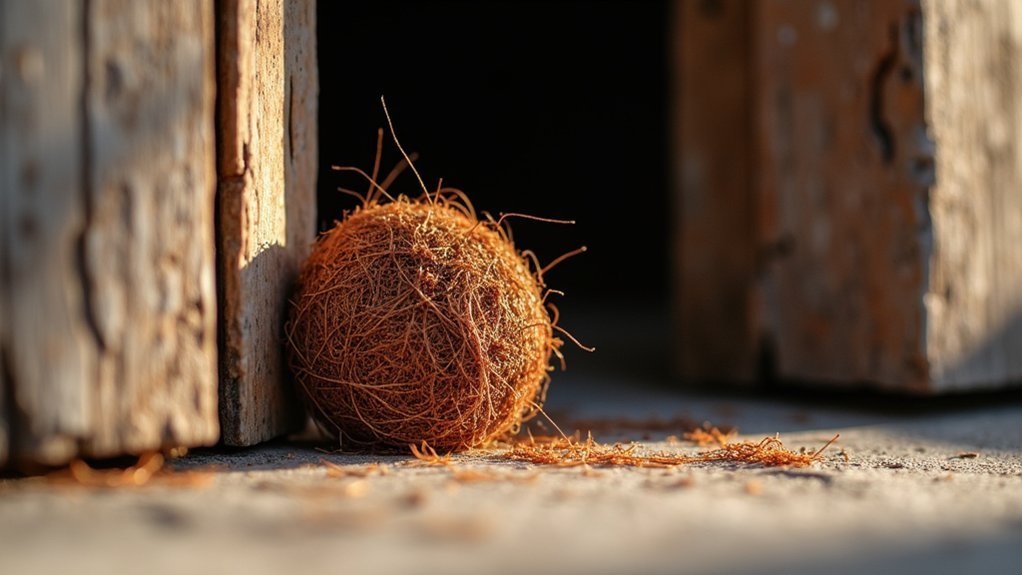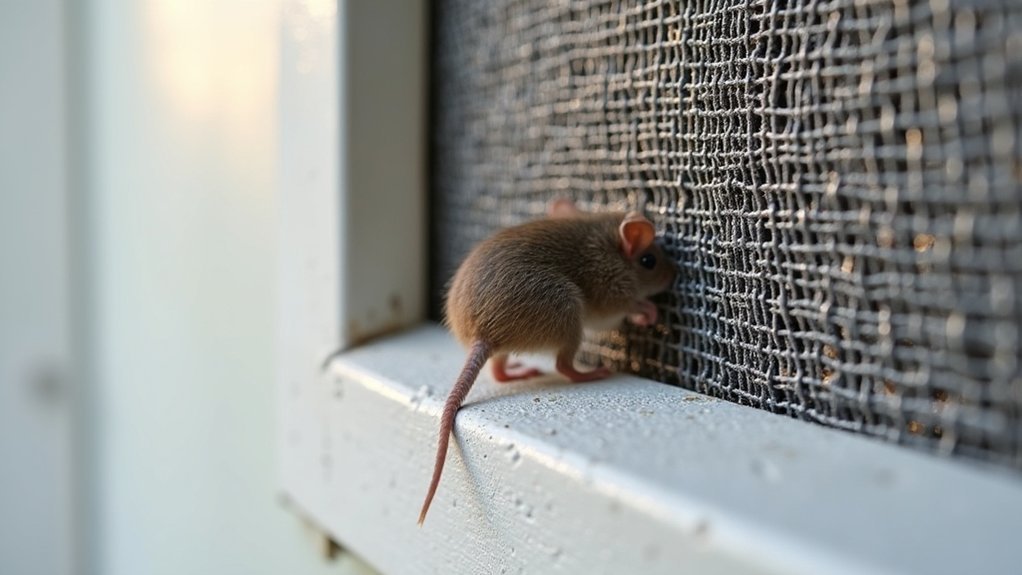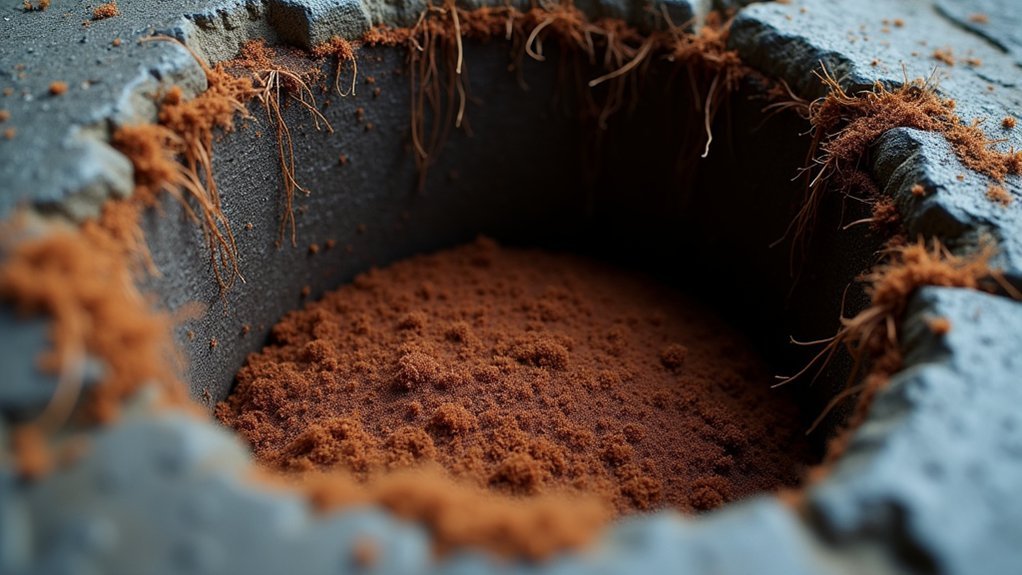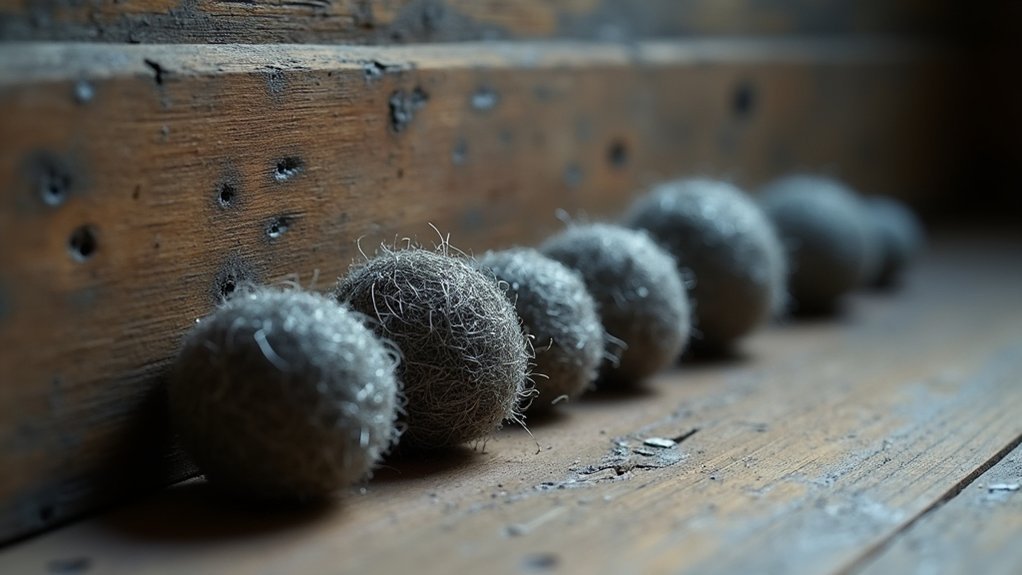Steel wool effectively blocks mice from entering your home through small gaps. Pack it tightly in openings, combine with caulk or expanding foam for larger areas, and use mesh screens for vents. Create reinforced barriers in high-traffic zones, seal foundation gaps with weather-resistant wool, and protect pipe entry points thoroughly. Check installations every 3-6 months, replacing rusted material immediately. These seven proven methods will transform your home into a rodent-proof fortress with proper implementation.
The Basic Steel Wool Stuffing Technique

Mice, those persistent household invaders, can squeeze through openings as small as a quarter-inch in diameter. To defend your home, scan for gaps larger than a pencil’s width around pipes, vents, and foundations where mice commonly enter.
Before sealing entry points, confirm surfaces are clean and dry for peak effectiveness. Cut steel wool into appropriate sizes, then firmly press it into small gaps, creating a durable barrier mice can’t chew through.
Confirm your tight packing leaves no slits or openings that could compromise protection. For enhanced security, apply a layer of caulk or foam over the steel wool to lock it in place.
Conduct maintenance checks every 3-6 months to verify your barriers remain intact, replacing any deteriorated wool to prevent mice from finding new access points.
Combining Steel Wool With Expanding Foam for Larger Gaps
While steel wool alone works well for tiny openings, larger gaps require a more substantial solution to keep mice at bay. By combining steel wool with expanding foam, you’ll create a durable barrier that rodents can’t penetrate.
| Step | Material | Purpose |
|---|---|---|
| 1 | Steel wool | Deters gnawing with coarse texture |
| 2 | Expanding foam | Seals edges and prevents displacement |
| 3 | Regular inspection | Maintains pest control effectiveness |
First, pack steel wool tightly into the gap. Then apply expanding foam around it, ensuring complete coverage. Wait for the foam to cure according to manufacturer instructions. This combination creates a weather-resistant seal that provides structural support while making the barrier impenetrable to rodents.
Remember to check your barriers periodically, as moisture can compromise materials over time. Replace any damaged sections promptly to maintain your pest control system.
Steel Wool Mesh Screens for Vents and Air Ducts

Because vents and air ducts provide ideal entry points for rodents, installing steel wool mesh screens offers essential protection for your ventilation system.
The coarse texture of steel wool for pest control effectively deters mice from chewing through these critical openings.
When securing your home, pack the mesh tightly into each vent to block small openings completely. For best results, combine steel wool with caulk or expanding foam in larger gaps to prevent future invasions by both rodents and insects. This combination creates a formidable barrier against unwanted visitors.
This durable and long-lasting solution requires minimal investment while providing months of protection.
Remember to inspect your screens regularly, as persistent mice may attempt to displace the material over time. With proper maintenance, your steel wool barriers will keep mice out effectively.
Reinforced Steel Wool Barriers for High-Traffic Areas
When blocking mice in high-traffic areas, you’ll need to use a double-layering technique that combines tightly packed steel wool with a secondary material like caulk or expanding foam.
For maximum protection, consider integrating metallic mesh with your steel wool barriers to create a nearly impenetrable defense against persistent rodents.
Cement-reinforced steel wool applications provide the ultimate long-term solution, especially around foundation gaps and exterior entry points where mice consistently attempt to gain access.
Double-Layering Technique Works
For high-traffic areas vulnerable to mouse intrusion, a single layer of steel wool often proves insufficient. The double-layering technique creates a robust barrier that rodents can’t chew through or displace.
When applying this method, pack the first layer tightly into gaps around pipes or other entry points, then add a second layer for reinforcement.
Using high-grade steel wool for both layers enhances durability and rust resistance, ensuring long-term protection.
For larger openings, combine your first layer with caulk or expanding foam before adding the second steel wool layer. This approach maximizes effectiveness by utilizing the material’s abrasive edges while creating a more formidable physical barrier.
Remember to inspect your double-layered installations regularly, as persistent mice may still attempt to breach these defenses, requiring occasional maintenance and reinforcement.
Metallic Mesh Combinations
Reinforced steel wool barriers offer superior protection when combined with metallic mesh in high-traffic areas. You’ll find this dual-barrier approach greatly enhances your pest control efforts against determined rodents. By layering galvanized wire mesh over tightly packed high-grade steel wool, you’re creating a formidable obstacle that mice can’t easily chew through or displace.
| Material Combination | Best For | Durability | Maintenance |
|---|---|---|---|
| Coarse Steel Wool + Galvanized Mesh | Large entry points | High | Quarterly inspection |
| Fine Steel Wool + Aluminum Mesh | Small cracks | Medium | Monthly check |
| Stainless Steel Wool + Copper Mesh | Outdoor openings | Very high | Bi-annual review |
| Bronze Wool + Steel Mesh | Humid areas | Rust-resistant | Seasonal assessment |
Remember to inspect these reinforced barriers regularly to maintain their effectiveness and immediately address any signs of deterioration or displacement.
Cement-Reinforced Applications
Creating a virtually impenetrable barrier, cement-reinforced steel wool applications represent the gold standard for protecting high-traffic areas from persistent rodent intrusion.
By embedding steel wool within cement, you’ll establish a robust defense that withstands weather conditions and heavy use while maximizing mice exclusion effectiveness.
This powerful combination works especially well for foundations, driveways, and pathways where traditional methods often fail.
The cement secures the steel wool in place, preventing rodents from displacing it, while the wool’s abrasive properties deter mice from attempting to gnaw through cracks and crevices.
Don’t forget to regularly inspect your cement-reinforced barriers for structural integrity.
Address any developing gaps promptly to maintain your protection system’s effectiveness and guarantee your property remains mouse-free year-round.
Outdoor Foundation Gap Sealing With Weather-Resistant Steel Wool
Three critical vulnerabilities exist around your home’s foundation where mice commonly gain entry.
To effectively seal potential gaps, use weather-resistant steel wool made from stainless steel or coated fibers that won’t rust when exposed to moisture.
Choose medium or coarse-grade steel wool for your outdoor foundation pest control. You’ll need to pack it tightly into crevices, ensuring no small openings remain where mice could squeeze through.
For maximum effectiveness, combine the tightly packed steel wool with sealant or expanding foam, creating a dual barrier against both rodents and water infiltration.
Don’t forget to inspect your foundation regularly, as environmental elements can deteriorate even weather-resistant materials over time.
Replace any compromised steel wool promptly to maintain your home’s protective barrier against unwanted visitors.
Pipe and Utility Entry Point Protection Methods

While foundation gaps receive much attention, pipe and utility entry points represent some of the most overlooked access routes for mice into your home.
These small holes around plumbing and electrical lines create perfect highways for rodents seeking shelter.
To effectively seal potential entry points, follow these proven methods:
- Examine thoroughly – Check where pipes enter walls, floors, and ceilings for gaps as small as a dime that could allow mice access.
- Pack tightly – Insert steel wool deeply into gaps, ensuring it can’t be easily pulled out by persistent pests.
- Combine materials – For larger openings, secure steel wool with expanding foam or caulk for enhanced pest control.
- Maintain regularly – Inspect your barriers quarterly, replacing any rusted steel wool to keep mice out long-term.
Steel Wool Maintenance and Replacement Schedule
Regular maintenance of your steel wool barriers is essential, with installations needing inspection every 3-6 months to guarantee their effectiveness against rodent intrusion.
You’ll need to replace any steel wool showing signs of rust or deterioration immediately, as moisture greatly reduces its blocking capabilities and structural integrity.
In humid environments, consider using stainless steel wool or other rust-resistant alternatives to extend the lifespan of your rodent-proofing measures.
Lifespan of Installations
Even the most meticulously installed steel wool barriers won’t last forever. The typical steel wool lifespan ranges from several months to a year, depending on moisture exposure and material quality.
Regular inspections every 3-6 months are essential to maintain an effective barrier against rodent entry.
Four vital factors affecting your installation’s durability:
- Environmental conditions – humidity and moisture accelerate deterioration
- Quality of steel wool used – higher grades resist rusting longer
- Installation method – properly sealed barriers last considerably longer
- Rodent activity – persistent pests may displace material over time
Don’t wait for a full rodent invasion before checking your barriers. Replace any steel wool showing signs of rust, compression, or displacement immediately.
In particularly damp areas, you’ll need more frequent inspections and replacements to guarantee continued protection against mice.
Moisture Considerations
Because moisture accelerates the oxidation process, your steel wool barriers can quickly transform from effective deterrents to useless rust patches in humid environments. To maximize longevity, monitor installation areas and protect your rodent exclusion efforts by layering steel wool with caulk or foam in gaps in walls.
| Condition | Maintenance Recommendation |
|---|---|
| Dry areas | Inspect every 6 months |
| Humid areas | Inspect every 3 months |
| First signs of rust | Replace immediately |
| High-moisture areas | Add protective caulk layer |
| After replacement | Dispose safely in containers |
Regular inspections are critical—steel wool in high-humidity environments might last only weeks compared to a year in dry conditions. When you notice rust forming, replace the material promptly to maintain effective barriers. Remember that proper disposal prevents fire hazards, so seal used steel wool in sturdy containers before discarding.
Frequently Asked Questions
Does Steel Wool Prevent Mice From Entering?
Yes, steel wool prevents mice from entering your home. You’ll find it effective because mice can’t chew through its sharp, coarse texture. Just make sure you’re packing it tightly into gaps and entry points.
How Do You Block Mice in Your Entrance?
To block mice at your entrance, identify gaps larger than a pencil, pack them tightly with high-grade steel wool, and seal with caulk or foam. Regularly check for activity and replace rusted or deteriorated wool.
How to Put Steel Wool Under a Door?
To put steel wool under a door, measure the gap first, cut appropriate strips, wear gloves for protection, and pack the wool tightly into the gap. You’ll want to secure it with caulk for better results.
Can Mice Chew Through Stainless Steel Wool?
No, mice typically can’t chew through stainless steel wool. Its dense, tough fibers and sharp edges deter them effectively. While not 100% chew-proof, it’s far more resistant than other materials you might use.
In Summary
You’ve now got seven effective steel wool techniques to keep mice out of your home. Remember, it’s not a one-and-done solution – you’ll need to regularly check and replace your barriers. Stay vigilant about maintenance, especially in high-risk areas and after severe weather. With these methods properly implemented, you’re well on your way to a mouse-free environment.





Leave a Reply